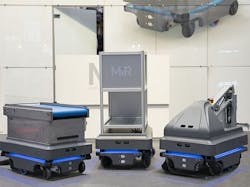Mobile Industrial Robots at Automate 2017: Autonomous mobile robots for logistics applications
Mobile Industrial Robots, a company that was launched in Denmark four years ago, was among the companies I had the chance to meet with at Automate 2017. As perhaps you could guess, the company develops mobile industrial robots that are designed to work collaboratively alongside people in applications including manufacturing, logistics and healthcare.
A US-based office in New York was opened only one year ago, but already there are 20 North American distributors that have signed on to start offering the robots. When asked why, Ed Mullen, Vice President, Sales, North America, told me that it’s the unique technology and design within these robots that make them so appealing.
"Everyone is familiar with AGVs [automated guided vehicles], but these are AMRs [autonomous mobile robots]," he said. "AGVs utilize fixed routes within companies, but with AMRs, we teach it a map and a system plans the best route."
In order for the robot to navigate autonomously, the system deploys laser scanners from SICK, which provide 360° visual protection around the robot, as well as an Intel RealSense 3D depth sensor, which enables the detection of objects ahead 50-500 mm above the floor. Additionally, there are four ultrasonic scanners that detect transparent objects ahead, such as glass doors.
The essence behind the design of the robots, Mullen explained, was to develop a robot that is easy to use, with an easy-to-use interface.
"There is a lot of value in the ability for companies to use automation themselves, instead of relying on integrators."
Logistics is an area that I’ve heard mentioned more frequently as one in which vision and automation use is increasing. When I asked about why this could be, Mullen framed his answer in the context of his company’s robots.
"Logistics floors spaces are often very big, so it gets down to how people are moving materials in these facilities," he said. "This is a fit for us, as our product helps to make people and companies more efficient, as it helps keep people more focused on tasks that make a company money, while letting the robots handle more mundane tasks."
Designed for such tasks as moving parts to productions, stocking parts, and so on, the robots are constantly being improved, as the short term roadmap is to improve the features of the current models, including the ability to navigate and move around more fluidly.
View more information on Mobile Industrial Robots.
Share your vision-related news by contacting James Carroll, Senior Web Editor, Vision Systems Design
To receive news like this in your inbox, click here.
Join our LinkedIn group | Like us on Facebook | Follow us on Twitter
Learn more: search the Vision Systems Design Buyer's Guide for companies, new products, press releases, and videos
About the Author

James Carroll
Former VSD Editor James Carroll joined the team 2013. Carroll covered machine vision and imaging from numerous angles, including application stories, industry news, market updates, and new products. In addition to writing and editing articles, Carroll managed the Innovators Awards program and webcasts.
